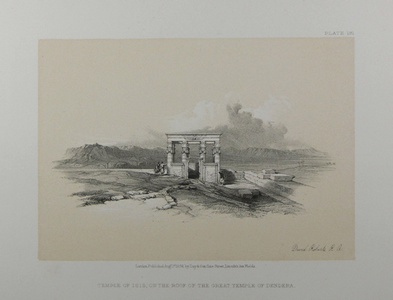| Method | Lithograph with tint stone |
| Artist | after David Roberts |
| Published | London, Published Augt. 1st. 1856, by Day & Son, Gate Street, Lincoln's Inn Fields |
| Dimensions | Image 123 x 175 mm, Sheet 205 x 285 mm |
| Notes |
Plate 191 from Volume 5 of the small format reprint of Roberts' The Holy Land, Syria, Idumea, Arabia, Egypt & Nubia. A view of the small kiosk of Isis at the temple complex of the town of Dendera, Egypt. The town of Dendera lies on the site of the ancient city of Tentyris, famous for its Greco-Roman Temple of Hathor. The temple, a Ptolemaic structure, was a much enlarged and embellished version of a pre-existing structure from the Middle Kingdom. Aside from being one of the most elegant and best preserved temples in Egypt, the complex is particularly famous for the Dendera Zodiac, a relief carving of the Egyptian astrological and astronomical system. The relief, now in the Louvre, was originally the ceiling of the Osiris chapel, a small pronaos of the larger Hathor temple. Robert's view shows the small 'Temple of the Birth of Isis' on the roof terraces of the Great Temple of Hathor. The small kiosk, with its Isis and Hathor headed columns, is open to the elements, the large enclosure walls that once surrounded it and the terrace now reduced to roof level. A group of three travellers rest against the temple and enjoy the view of the surrounding region from the heights of the terrace. David Roberts RA (24th October 1796 – 25th November 1864) was a Scottish painter. He is especially known for a prolific series of detailed prints of Egypt and the Near East produced during the 1840s from sketches made during long tours of the region (1838-1840). This work, and his large oil paintings of similar subjects, made him a prominent Orientalist painter. He was elected as a Royal Academician in 1841. The firm of Day & Haghe was one of the most prominent lithographic companies of the nineteenth-century. They were also amongst the foremost pioneers in the evolution of chromolithography. The firm was established in 1823 by William Day, but did not trade under the moniker of Day & Haghe until the arrival of Louis Haghe in 1831. In 1838, Day & Haghe were appointed as Lithographers to the Queen. However, and perhaps owing to the fact that there was never a formal partnership between the two, Haghe left the firm in the 1850's to devote himself to watercolour painting. The firm continued as Day & Son under the guidance of William Day the younger (1823 - 1906) but, as a result of a scandal involving Lajos Kossuth, was forced into liquidation in 1867. Vincent Brookes bought the company in the same year, and would produce the caricatures for Gibson Bowles' Vanity Fair magazine, as well as the illustrations for Cassells's Poultry Book, amongst other commissions. Condition: Light foxing to margins, not affecting image. |
| Framing | unmounted |
| Price | £30.00 |
| Stock ID | 39185 |

